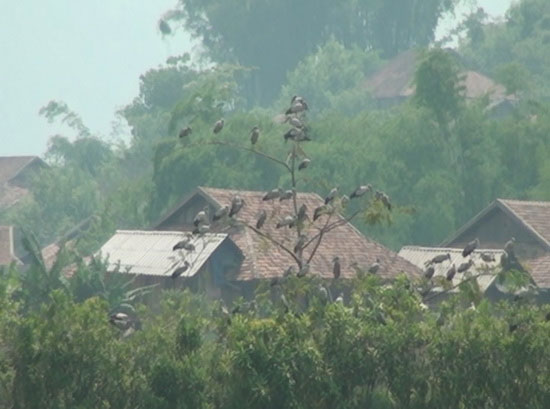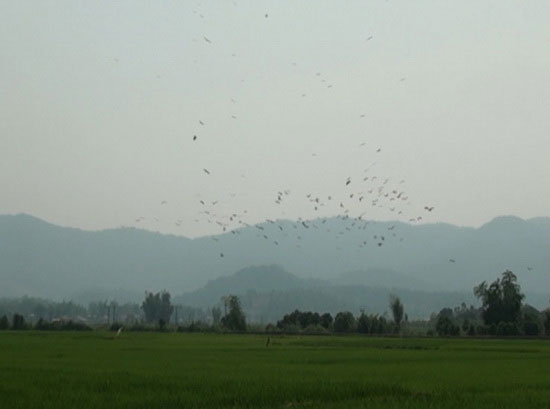Protection of a rare and precious herd of flocks in Muong Phang commune
Recently, in the area of Muong Phang commune, Dien Bien district, Dien Bien province, there have been rare and precious stalks, included in the Vietnam Red Book.
>>>Appeared rare herds of snails in Quang Tri
In the morning and afternoon every day, the herd flock up to hundreds of children appear in the rice fields of Muong Phang commune to find food.
It is worrisome that the fate of hundreds of these stalks is facing the dangers of day by day people in the area are looking for ways to hunt and trap these rare birds.
Many people living in the area said that every time from 6 to 10 hours and 14 to 16 hours daily, the flock often appears on the rice fields of the people in the commune.
Storks feed in many rice fields but are concentrated in the fields of Phang 1, Phang 2, Phang 3, Dong Mang, Bua villages and in the fields of Tan Binh and Pretty villages (scattered around the relic site). Commander Dien Bien Phu Campaign) with hundreds of children. Peak, the number of stalks in Muong Phang commune is up to nearly 500 individuals.
Mr. Luong Van Quan, from Bua village, said: 'This bird has been here for over a week. When it appears, it often flies in the sky for a while to swoop down to the field to feed or something. Its shape is like a stork, crane but it is much bigger, its beak and legs are also very long. These birds are also brave people, when people come near them, they will fly away, then come down in the nearby fields. I don't know what kind of bird it is. "


Being present at Ban Bua early one morning, our reporter recorded the image of this flock. The point in the sky is the image of a herd of nearly 300 flocks. The bottom of the rice field is dozens of other storks moving in search of prey. After dozens of minutes of flying, the herd of birds flocked to park the bamboo bushes, the stems and branches of low-altitude trees growing next to the fields or small tissues in the field.
In the opinion of many people in the area, the water level of Pa Khoang reservoir is low, the area of the reservoir is dry so the food source such as abundant shrimp, fish, aquatic has attracted this bird to come here to feed. . Muong Phang commune has many forest areas that are safe and suitable for this bird to reside.

However, many people in the area have invited each other to trap this herd. After nearly 1 hour of visiting the field, wading on the fields that the herd had just flown, we counted nearly 20 traps that were located in remote locations, nearly different on people's fields. Bua version. The mechanism of operation of the trap is simple, but the effectiveness is very high: When the stork steps into the noose, immediately trap it and bounce off the vertical shaft, then the trap will turn on, tighten the noose, tied the leg or neck of the stork.
According to Mr. Tuan Van Noi, commune forest ranger, the propaganda prohibits people in the area to hunt and consume wild animal products, birds and birds have been coordinated with commune authorities and forest protection officials. done when meeting people. Local people also signed commitments on these contents.
However, according to Mr. Noi, the propaganda content is difficult to implement in the people because 'people here, many people know (contents signed commitment) but people ignore . Meetings, representatives for families to attend meetings usually women ".

Stork trap
Regarding this issue, Mr. Pham Van Khien, Deputy Director of Dien Bien Provincial Forest Protection Department, Head of Dien Bien District Forest Protection Department said that the caterpillar is very adaptable to areas with favorable conditions to reside. , find bait. Muong Phang Commune is an area with diverse habitat (fields, rivers, lakes, forests and mountains .), so the migrations have migrated here to feed and live.
He said about the responsibility of the sector, the unit will carry out the task of checking the situation so that it can assign specific tasks to the local forest rangers to coordinate well with the local authorities to promote propagation and improvement. awareness and awareness of protecting stork flocks for local people; At the same time, it will strengthen the handling of violations in any form (hunting, shooting, trapping), affecting the herd to protect the number of storks in the best way.
Stork (also called Co Oc), the scientific name is Anastomus oscitans, belonging to the Heron family, the crane family, in the R-rank (extremely rare) in the Vietnam Red Book. In the world, stalks often live in countries in South Asia and Southeast Asia.
In Vietnam, the stork only appears in a few localities in the Western South and Tay Ninh. Storks have a weight of between 1 and 1.2 kg, with the characteristics of settling down; But when the area of residence, where food is narrowed, they migrate to other areas more conveniently. The main food of this bird is snail, aquatic animals.
- Detecting rare leopards in Lam Dong
- Proposing to supplement 37 endangered and rare species prioritized protection
- Son La: Rushing to see the giant white poisonous, strange and big mushroom like a nan fan
- Terrible hail ravaged Muong Khuong
- Detecting strange birds first appeared in Muong Nhe
- Dak Nong found two sets of rock colonies dating back more than 3,000 years
- Detecting plants with horse-ear leaves in Vietnam
- Preservation and successful development of rare and precious species of catfish
- Why does China restrict rare earth mining?
- Phu Tho has successfully researched and produced rare and precious fish
- Discovering rare and precious orchids named in the red book
- Discovering rare and precious orchid species in Quang Tri
 Animal 'suffering' after hibernation
Animal 'suffering' after hibernation Why do goats climb well?
Why do goats climb well? Scientists were surprised to see chimpanzees eating turtles
Scientists were surprised to see chimpanzees eating turtles Giant catfish died deadly due to drought in Thailand
Giant catfish died deadly due to drought in Thailand